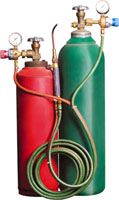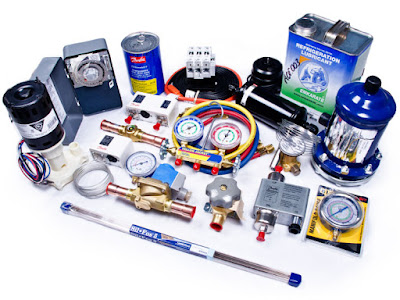Tipos de tuberías para la refrigeración
TIPOS DE TUBOS
La mayor parte del tubo que se usa en acondicionamiento de aire está hecho de cobre. Sin embargo, hoy en día el aluminio se usa mucho para fabricar los circuitos internos sé los serpentines del evaporador y condensador, aunque no se ha extendido su uso en fabricación en el campo porque no se puede trabajar con tanta facilidad como el cobre, y es más difícil de soldar.
La tubería de acero se usa para armar los sistemas de refrigeración muy grandes en los que se necesitan tubos de 6 pulg de diámetro o mayores. En la refrigeración moderna no se usan conexiones roscadas de tubo de acero, porque no se puede hacer herméticas.
Estos sistemas son soldados, y cuando se necesita conectar al equipo o se necesitan uniones de servicio se usan conexiones atornilladas.
El término tubing se aplica en general a materiales de pared delgada, que se unen mediante sistemas que no sean de rosca cortada en la pared del tubo. Por otro lado, el término tubo común y corriente es el que se aplica a materiales con pared gruesa, como por ejemplo hierro y acero, en los cuales se pueden cortar roscas en la pared y que se unen mediante conexiones que se atornillan en el tubo.
Estos tubos también se pueden soldar. Otra diferencia entre “tubing” y tubo es el método de medición de tamaño. Los tamaños de “tubing” se expresan en términos del diámetro exterior (DE), y los del tubo se expresan como diámetros nominales interiores (DI).
“TUBING” DE COBRE
Este “tubing”1 se usa en la mayor parte de los sistemas domésticos de refrigeración, y es cobre especialmente reconocido. Cuando se forma el tubo de cobre tiene una tendencia a endurecerse, y esta tendencia podría originar grietas en los extremos del “tubing” cuando se avellanan o se aplanan.
El cobre se puede reblandecer por calentamiento hasta que su superficie tenga color azul, y dejándolo enfriar. A este proceso se le llama recocido y se hace en fábrica.
El “tubing” de cobre que se usa en refrigeración y acondicionamiento de aire sé llama_tubing ACR, que quiere decir que se usa en trabajos de refrigeración y ante acondicionado, y que se ha fabricado y procesado especialmente para este objeto. El “tubing” ACR tiene nitrógeno a presión para evitar la entrada de aire, humedad y polvo, y también para dar máxima protección contra los óxidos perjudiciales que se forman normalmente durante el latonado.
Los extremos están taponados, y los tapones se deben volver a poner después de cortar un tramo del “tubing”.
Clasificación del “tubing” de cobre
El “tubing” de cobre tiene tres clasificaciones: K, L y M, que se basan en los espesores de pared:
K: pared gruesa, aprobado para refrigeración y aire acondicionado
L: pared media, aprobado para refrigeración y aire acondicionado
M: pared delgada; no se usa en sistemas de refrigeración.
El “tubing” M de pared delgada no se usa en tuberías de refrigerante a presión, porque no tiene el espesor de pared necesario para cumplir con los reglamentos de seguridad; sin embargo, se usa en tuberías de agua, drenado de condensados y otras necesidades relacionadas con el sistema.
El “tubing” K de pared gruesa se emplea en usos especiales, cuando se esperan condiciones excepcionales de corrosión. El tipo L es el que se usa con más frecuencia para aplicaciones normales en refrigeración. La figura R5-2 muestra una tabla de especificaciones para “tubing” tipos K y L. Ambos tipos se consiguen en variantes de extrusión suave o dura.
“Tubing” de cobre extruido suave
Como su nombre lo dice, se recuece para hacer que el tubo sea más flexible y fácil de doblar y conformar. Se consigue en el comercio en tamaños de ⅛″ a 1 ⅝″ DE y se vende con frecuencia en rollos de 7.5, 15 y 30 metros. Los rollos se deshidratan y sellan en fábrica. El “tubing” de cobre suave se puede soldar o usar con conexiones abocinadas o mecánicas de otro tipo.
Como se dobla y se conforma con facilidad debe sujetarse con abrazaderas u otros componentes para soportar su propio peso.
1N de T.: En español no se diferencia entre tubo “tubing” y tubo “pipe”; el contexto es lo que define lo que se trata. Sin embargo, en este capítulo sí haremos la distinción, y en el resto del libro sólo usaremos la palabra “tubing” cuando sea necesario aclarar para que el lector no se confunda.
DIÁMETRO
Exterior, Interior, Espesor de Weight per
Tipo Pulg. Pulg. Pared, pulg Foot (lb)
K ½ 0.402 0.049 0.2691
⅝ 0.527 0.049 0.3437
¾ 0.652 0.049 0.4183
⅞ 0.745 0.065 0.6411
1⅛ 0.995 0.065 0.8390
1⅜ 1.245 0.065 1.037
1⅝ 1.481 0.072 1.362
2⅛ 1.959 0.083 2.064
2⅝ 2.435 0.095 2.927
3⅛ 2.907 0.190 4.003
3⅝ 3.385 0.120 5.122
L ½ 0.430 0.035 0.1982
⅝ 0.545 0.040 0.2849
¾ 0.666 0.042 0.3621
⅞ 0.785 0.045 0.4518
1⅛ 1.025 0.050 0.6545
1⅜ 1.265 0.055 0.8840
1⅝ 1.505 0.060 1.143
2⅛ 1.985 0.070 1.752
2⅝ 2.465 0.080 2.479
3⅛ 2.945 0.090 3.326
3⅝ 3.425 0.100 4.292
Su aplicación más frecuente es para tamaños de tuberías de ¼″ a ¾″ DE.
Cuando el diámetro es mayor que, se hace difícil él darle forma.
“Tubing” de cobre extruido duro
Este “tubing” también se usa mucho en sistemas comerciales de refrigeración y aire acondicionado. A diferencia del extruido suave, es duro y rígido y tiene la forma de tramos rectos. Se debe usar con conexiones formadas para dar los cambios de dirección y dobleces necesarios. A causa de su construcción rígida es más auto soportante y necesita de pocos soportes. Sus diámetros van de ⅜″ a más de 6″.
El “tubing” extruido duro se vende en tramos normales de 6 m que están deshidratados, cargados con nitrógeno y taponados en ambos extremos para mantener una condición interna limpia y libre de humedad. El empleo de “tubing” extruido duro se asocia con más frecuencia con tamaños mayores de tubería, de ⅞″ o más.
TYPES OF PIPES
Most of the tube used in the air conditioning is made of copper. However, nowadays aluminum is widely used to manufacture the internal circuits the evaporator coils and condenser, but has not spread use in manufacture in the field because you can not work as easily as copper, and is more difficult to weld.
The steel pipe is used to build very large systems where cooling pipes 6 inches in diameter or larger are required. In modern cooling unthreaded steel pipe connections are used, because you can not airtight.
These systems are soldiers, and when you need to connect to equipment or service unions are needed bolted connections are used.
The term applies tubing generally thin-walled materials, which are joined by systems other than cut thread in the tube wall. Furthermore, the term ordinary tube is applied to materials with thick wall, such as iron and steel, in which can be cut threads in the wall and which are joined by connections which are screwed into the tube .
These pipes can also be welded. Another difference between "tubing" and is the tube size measurement method. The sizes of "tubing" are expressed in terms of outside diameter (OD) and pipe interiors are expressed as nominal diameters (DI).
"TUBING" COPPER
This "tubing" 1 is used in most domestic refrigeration systems and is particularly recognized copper. When formed copper tube has a tendency to stiffen, and this trend could result in the ends of cracks "tubing" when countersink or flattened.
Copper can be softened by heating until its surface has blue, and allowing it to cool. This process is called annealing and is factory.
The "tubing" copper used in refrigeration and air conditioning llama_tubing ACR, which means that work is used in refrigeration and conditioning before, and which is manufactured and processed specifically for this purpose. The "tubing" ACR nitrogen-pressurized to prevent ingress of air, moisture and dust, and also to give maximum protection against harmful oxides are usually formed during brazing.
The ends are plugged, and plugs should be put back after cutting a section of "tubing".
Classification of "tubing" copper
The "tubing" copper has three classifications: K, L and M, which are based on wall thickness:
K: thick-walled, approved for refrigeration and air conditioning
L: half wall, approved for refrigeration and air conditioning
M: thin wall; not used in refrigeration systems.
The "tubing" M thin wall is not used in pressurized refrigerant pipes, because it has the wall thickness necessary to comply with safety regulations; however, it is used in water pipes, drain condensate and other needs related to the system.
The "tubing" K thick-walled is used in special applications where exceptional corrosion conditions are expected. The type L is used more frequently for normal refrigeration applications. The R5-2 shows a table of specifications for "tubing" types K and L. Both variants are available in soft or hard extrusion.
"Tubing" soft extruded copper
As its name says, it is annealed to make the tube more flexible and easy to bend and shape. It is available commercially in sizes from ⅛ "to 1 ⅝" DE and is frequently sold in rolls of 7.5, 15 and 30 meters. The rolls are dehydrated and sealed at the factory. The "tubing" soft copper can be welded or use with splayed or other mechanical connections.
As it bends and conforms easily be secured with clamps or other components to support its own weight.
1N T .: In Spanish does not differentiate between tube "tubing" and tube "pipe"; the context is what defines what it is. However, this chapter will distinguish itself, and the rest of the book we will use only the word "tubing" when necessary to clarify that the reader is not confused.
Its most common application is for pipe sizes from ¼ "to ¾".
When the diameter is greater than, it becomes difficult to shape.
"Tubing" hard extruded copper
This "tubing" is also widely used in commercial refrigeration systems and air conditioning. Unlike the soft extrudate, it is hard and rigid and has the form of straight sections. It should be used with connections formed to give direction changes and bends necessary. Because of their more rigid construction it is self-supporting and requires few supports. Their diameters range from ⅜ "to more than 6".
The "tubing" hard extruded sold in normal sections 6 m that are dehydrated, loaded with nitrogen and capped at both ends to keep clean and free internal moisture condition. The use of "tubing" extruded hard more often associated with larger sizes of pipe, ⅞ "or more.



Comentarios
Publicar un comentario